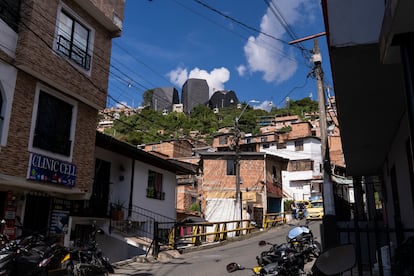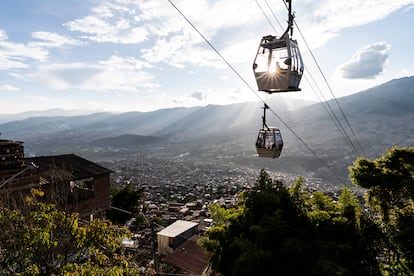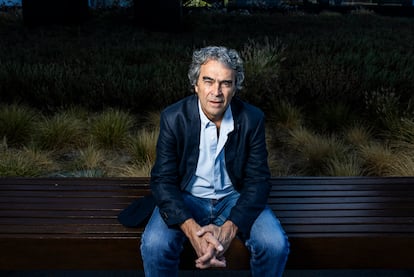The paramilitaries and their supporters stormed Medellín. More than 30,000 individuals dressed in pristine white and summoned by far-right armed militias marched on the capital of Paisa that afternoon in March 2004. A demonstration of force under the disturbing slogan “Colombia fights” that celebrated the armistice agreed with the Government of former president Álvaro Uribe. The cheers for the country that echoed in the streets reached the office of the then mayor, Sergio Fajardo, who was able to watch the parade from his window. “It shocked me a lot,” he recalled at the beginning of October during a visit to Madrid. “Their enormous influence made me think that we should take away space from them little by little,” reveals the politician. Less than a year later, his team organized a free Juanes concert on the same avenue where the death squads had paraded. Some 120,000 attendees vibrated together and illuminated the dark night of Medellín.
Mathematician, professor and candidate of the center for the Colombian presidential elections next year, Sergio Fajardo (Medellín, 69 years old) now settles accounts with his past. He does it in city without walls (Editorial Eafit), an essay on the power of urban planning and architecture designed together with his closest collaborator—the designer Alejandro Echeverri—and half a dozen community leaders from the northeastern area, the most impoverished. Together they mapped the territory inch by inch. During their mandate, between 2004 and 2008, they planned new parks, health centers, libraries, built social housing and pedestrianized part of the spine of Medellín (2.6 million inhabitants) when restrictions on road traffic seemed just a chimera. “We change the skin of the city,” stated Fajardo at the IE University of Madrid, where he presented the publication within the framework of a program on public leadership. “We did great things and until now we had never analyzed them collectively.”
They learned about the needs of the neighborhoods through participatory processes that were unprecedented at that time and that are studied today as examples of governance. They later developed the so-called Comprehensive Urban Projects (PUI), a hybrid planning tool that combined actions in the field of education, health, public space and culture. “We were with the people, we had walked every corner of Medellín and we knew their needs,” testifies Fajardo, who remembers the social trauma of violence. “The fear was still noticeable, we had to repair trust in the institutions, encourage people to go out into the streets.” The leaders of the paramilitary forces, the cartels and the guerrillas had fought with iron and fire for every meter. The capital of Paisa was the scene of almost 70,000 violent deaths in the last two decades of the 20th century, a homicide rate 20 times higher than today.
Fajardo’s mandate coincided with a few years of peace between groups, the so-called “Dobernability”, sponsored by Diego Murillo, alias Don Bernaa drug trafficker who joined the paramilitary ranks. Together with the armistice of former President Uribe, this process opened a window of opportunity that the then first mayor knew how to take advantage of. It recovered degraded areas that were very difficult to access for administrations until that time. Under the maxim of “the most beautiful for the most humble”, he called an architectural competition aimed at erecting the España Library – inaugurated in 2007 by King Juan Carlos – next to a peri-urban neighborhood of informal buildings. The design earned its author, Giancarlo Mazzanti, the first prize at the Ibero-American Biennial of Architecture and Urbanism. “Each building has an integration project behind it, we understood architecture as a lever for social change,” says Fajardo.

The library that peeks out from among the low houses and can be seen from almost any point in the city embodies the symbol of a new time. Among the most emblematic projects of the time, Parque Explora also stands out, an open-air science museum that has the largest aquarium in South America. And the Botanical Garden, 13 hectares of thickets dotted with architectural interventions such as the Orquideorama, a wooden canopy that protects the Book Festival stands every September. “It was not just about creating new meeting spaces, we also wanted to provide them with content,” says the former councilor. “The old book fair was organized in a closed area where no one went. We took it out into the streets, looking at ourselves in the mirror of Madrid or Guadalajara. We included the term party in the name to turn it into just that, a celebration.”
Medellín is located in the heart of the Aburrá valley. Its location made it a fortress for the armed militias that took cover in the upper neighborhoods. The rehabilitation of the Juan Bobo and La Herrera ravines—named for their location in two gorges—serve as a model of the social urbanism of Fajardo and Echeverri. This term that both coined during the electoral campaign could seem redundant if it were not for the fact that a good part of the world’s cities are still designed with their backs to their residents. “The idea was to improve the living conditions of these areas through urban design,” Fajardo says, later arguing that his policies contributed to “strengthening peace.” In the ravines, the City Council not only replaced many self-constructions with protected housing, but also acquired plots to create new public spaces from scratch. “They had never had them.”
“Governing is getting an architect and a social worker to operate in the same direction,”
Sergio Fajardo
Colombian analysts agree that Fajardo is a rare review in the party ecosystem. A professor with carefully tousled hair who refuses to forge alliances with local oligarchs in the Colombia of clientelism. The son of a famous architect, a regular bicycle user and a doctorate in the United States, he started in local politics without any previous experience. He distributed leaflets at traffic lights to make himself known as a candidate for mayor. After losing his first election, he says he dedicated the following four years to “joining forces with activists, academics and businessmen.” His strategy ended up paying off and he swept the following elections. That idealistic Fajardo who recently arrived in public life differs in certain aspects from the current one: it would not be unreasonable to think that he has lost freshness and is leaning to the right on issues such as security.

city without walls It is an exercise in territorial assertion that offers lessons for public management. “Governing is organizing technical teams, ensuring that an architect and a social worker operate in the same direction,” says Fajardo. If the text has aroused the interest of urban planners and sociologists in Europe, in Colombia it soon disappeared from the novelties table of bookstores. Perhaps because of the political polarization that the country is going through and for which the professor blames the president, Gustavo Petro. Fajardo did not run again in the local elections and, ultimately, assumed the governorship of Antioquía for four years. He recognizes that his project in Medellín lacked “political continuity and consolidating new leadership capable of retaking the Mayor’s Office.” Several of the infrastructures that he promoted fell into oblivion, losing transformative potential. The social and urban walls began to rise again.
“Part of the problem is that we have left a void after our success,” Fajardo admits with some regret, to whom most of the polls for the presidential elections grant a third position. The old order of the paramilitaries and the Medellín insurgency has been replaced in recent years by a platform of criminal groups that act with stealth. They extort and punish the population with forced displacement, murder is their last resort. These neighborhood gangs made up of young people hungry for weapons and gasoline today exercise implacable power in various parts of the northeastern commune, affected by unemployment and poverty. Its streets still insist on remembering the mayor who once brought down the walls of Medellín with the weapons of architecture.

